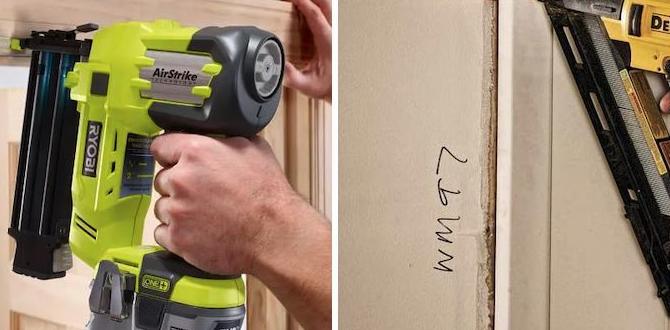Imagine you’re building a dollhouse. You have tiny chairs and a small bed, but what tool do you use to keep them together? The same question arises when you’re fixing your home’s trim. Many wonder, “What size finish nailer for trim is best?” Choosing the right tool makes a big difference. It’s like using the perfect crayon to color within the lines. Without the right nailer, the trim may not fit snugly. Would you use a giant hammer for small nails? Probably not! With the right size finish nailer, you get a clean and neat finish every time. Let’s explore why size matters so much.
Table of Contents
Choosing The Right Finish Nailer Size For Trim Work

Choosing the Right Finish Nailer for Trim
Selecting the perfect finish nailer for trim makes your project shine. Did you know that nail size can influence the outcome? For most trim work, a 16-gauge nailer works best. It’s strong yet leaves a tidy finish. A 15-gauge offers extra holding power for heavier pieces. Wondering about smaller trims? An 18-gauge nailer provides a delicate touch. Choosing the right size nailer ensures every piece of trim sits just right, making your efforts worth it.
Understanding Finish Nailers
Definition and Purpose of Finish Nailers. Types of Finish Nailers: Pneumatic vs Cordless.
Finish nailers are handy tools in carpentry, like magic wands but for builders. Their superpower? They zap nails into trim, making everything look neat and fancy. These tools are often used when you want to create a polished finish on woodwork or furniture. There are two main types: pneumatic and cordless. Think of pneumatic ones as Iron Man—strong and air-powered. The cordless ones are more like Spider-Man—nimble and battery-powered. Each type has its perks. Prefer less hassle with cords? The cordless finish nailer is your buddy! But if you enjoy the power of a roaring machine, the pneumatic might be the way to go. Here’s a quick look:
| Type | Power Source | Best For |
|---|---|---|
| Pneumatic | Air Compressor | Heavy-Duty Work |
| Cordless | Battery | Flexibility |
Why Size Matters in Trim Projects
Impact of Nail Size on Trim Stability. Aesthetic Considerations for Trim Finish.
Using the right nail size is crucial in trim projects. It ensures the trim stays in place and looks good. If the nails are too small, the trim may fall off. Larger nails can damage the wood. The right size keeps everything secure, making the trim look neat and professional.
- Choose wisely for lasting results.
- It affects the home’s beauty.
- Remember, size impacts stability and appearance. Next time you work on a trim, think nail size!
What size nail is best for trim?
For most trim work, 16-gauge finish nails are a great choice. They are strong yet thin enough to blend into the trim. This size helps keep trim secure without damage.
Can nail size affect trim installation?
Yes, the size of the nails can definitely affect trim installation. Small nails may not hold the trim securely, while large nails can split the wood. The right size makes installation easier and more effective.
Common Sizes of Finish Nails for Trim
15Gauge Finishing Nails: HeavyDuty Applications. 16Gauge Finishing Nails: Versatile Choice. 18Gauge Brad Nails: Delicate and Detailed Work.
Choosing the right finish nails for trim can be like picking the right socks – it’s all in the details! For heavy-duty projects, 15-gauge nails are your best bet. They hold on tight, much like an octopus with a favorite toy. If you’re looking for versatility, 16-gauge nails are perfect. They are like the superheroes of nails, ready for any task. For delicate work, opt for 18-gauge brad nails – they’re gentle and caring, like a grandma with cookies. Here is a quick look at when to use each:
| Nail Size | Best For |
|---|---|
| 15-Gauge | Heavy-duty applications |
| 16-Gauge | Versatile projects |
| 18-Gauge | Delicate, detailed work |
Now, if you’re wondering, “What size finish nailer for trim?” consider what type of work you’re doing. For beefy projects, go heavy; for gentle projects, go light. And remember, finishing nails are like chocolate chip cookies – it’s all about finding the right size. According to experts, choosing the correct gauge is key. It creates a professional finish and brings out the best in materials. As the saying goes, “Measure twice, nail once!”
Choosing the Right Finish Nailer Size
Analyzing the Trim Material and Thickness. Factors Influencing Nail Penetration and Hold.
When dealing with trim materials, size is everything – not unlike making the perfect pizza. You wouldn’t slap a large topping, like a pineapple, on a thin crust, would you? The same logic applies to choosing a finish nailer size. First, look at the trim material and its thickness. Thicker trim, like oak or mahogany, needs a heavier-duty approach, like a 15-gauge nailer, while thinner, delicate trims may only need a lighter, 18-gauge model. The nail must go deep enough to grab hold like it’s hugging a tree and stay there through parties and maybe even earthquakes. If you don’t want trim popping out to show off, choose the right size for a snug fit. Remember, you wouldn’t want it to fall over like your uncle after Thanksgiving dinner. The following table gives a guideline for nail sizes based on trim thickness, ensuring you’re not swinging a sledgehammer to swat a fly.
| Trim Material | Trim Thickness | Suggested Nail Size |
|---|---|---|
| Pine or MDF | 1/2 inch | 18-gauge |
| Oak | 3/4 inch | 16-gauge |
| Mahogany | 1 inch | 15-gauge |
With the right size in play, you’ve got trim that will sit pretty, hold tight, and pass the ‘uncle nudge’ test. Use this guide, and may your trim be forever straight and secure!
Pros and Cons of Different Nailer Sizes
Evaluating Strength and Holding Power. Assessing Flexibility and Ease of Use.
Nailers come in various sizes. Each size has its own pros and cons. The bigger nailers provide stronger holding power. They can keep things tightly connected. But, they’re heavier. Smaller nailers are lighter. They offer flexibility and ease of use. Yet, they may not hold as strong. Picking the right size is all about balancing strength with ease.
What size nailer should I use for trim?
For trim work, a finish nailer that uses 15 or 16-gauge nails is often the best choice. These provide the right balance of holding power and a neat finish. You want nails that won’t split the wood. Ensure your finish nailer fits comfortably in your hand for best results.
Does nail size affect ease of use?
Yes, it does. Smaller nailers are easier to handle and control. They help in tight spaces. But, larger nailers handle bigger jobs quickly, though they may be tiring for long tasks. Consider what feels comfortable for you.
Tips for Using a Finish Nailer on Trim
Proper Nailing Techniques for Clean Results. Safety Tips and Maintenance of Finish Nailers.
Using a finish nailer on trim can be like nailing jelly to a wall—tricky but fun! First things first, hold the nailer straight for neat results. If it’s at an angle, even your trim might be embarrassed! For safety, keep fingers out of the danger zone, because fingers do their best work attached! And don’t forget some quick hugs for your nailer—clean it often so it doesn’t go on strike in front of guests. Below is a quick guide:
| Tips | Explanation |
|---|---|
| Proper Nailing | Keep the nailer straight and aim accurately. |
| Safety | Wear goggles and keep hands safe. |
| Maintenance | Clean regularly to ensure smooth performance. |
Finish nailers vary in size, but for trim, a 16-gauge is popular. It’s the goldilocks of nailers—just right! Using smaller nails can make trim look snug and secure, avoiding unsightly holes bigger than a black hole in the living room. As quotes go, “Measure twice, cut once,” is gold in the trim nailer world.
Case Studies: Real-World Application of Finish Nailers in Trim Work
Examples from Construction Professionals. Lessons Learned and Expert Recommendations.
In real life, finish nailers make trim work easy. Builders use them for smooth and neat results. What size finish nailer fits best for trim? Pros suggest a 15 or 16-gauge for most trim tasks. They are strong and great for variety. Builders in Texas say, “It saves us heaps of time.” Experts highlight lessons: keep your tools clean and select the right nails. A perfect fit avoids troubles and delays. Always test on scrap wood to ensure the right finish.
Conclusion
For trim work, a 15 or 16-gauge finish nailer is best. These nailers hold trim securely without splitting wood. Always check your project requirements before deciding. Remember to practice with your nailer for best results. For more tips, explore more resources and guides about using nailers effectively. Happy woodworking!
FAQs
What Gauge Of Finish Nailer Is Best Suited For Installing Baseboards And Crown Molding Trim?
For installing baseboards and crown molding trim, use a 16-gauge finish nailer. It is strong yet gentle enough. The 16-gauge means the nails are thick and hold pieces firmly. It’s perfect for making your home look neat and beautiful!
How Does The Size Of Finish Nails Impact The Stability And Appearance Of Trim Work?
The size of finish nails affects how strong and neat trim work looks. When we use bigger nails, they hold trim pieces more tightly, making them stable. Smaller nails leave tiny holes, so the trim looks smooth and nice. By choosing the right size, we make sure trim stays in place and looks good.
Can A 15-Gauge Finish Nailer Be Used For All Types Of Trim, Or Are There Specific Cases Where A Smaller Gauge Might Be Better?
A 15-gauge finish nailer is great for heavy trims, like big baseboards. But for small trims, a smaller nail might be better. A smaller gauge, like 18-gauge, leaves tiny holes. These are easier to hide and work better on delicate pieces. So, using the right size nail helps your project look neat.
What Are The Advantages And Disadvantages Of Using A 16-Gauge Versus An 18-Gauge Finish Nailer For Trim Installation?
When you use a 16-gauge finish nailer, it’s strong and holds heavy pieces better. But, it’s bigger and can make larger holes in the wood. An 18-gauge finish nailer is smaller and makes tinier holes, which looks nicer. However, it isn’t as strong for holding heavy things. It’s all about choosing what’s best for what you need to do.
How Do You Determine The Appropriate Nail Length For Different Trim Thicknesses When Using A Finish Nailer?
To pick the right nail length, first measure the wood’s thickness. The nail should be about three times longer than the wood. This helps the nail hold the pieces tightly together. If the wood is half an inch thick, use a nail that is one and a half inches long. This keeps the trim secure and prevents it from falling off.







